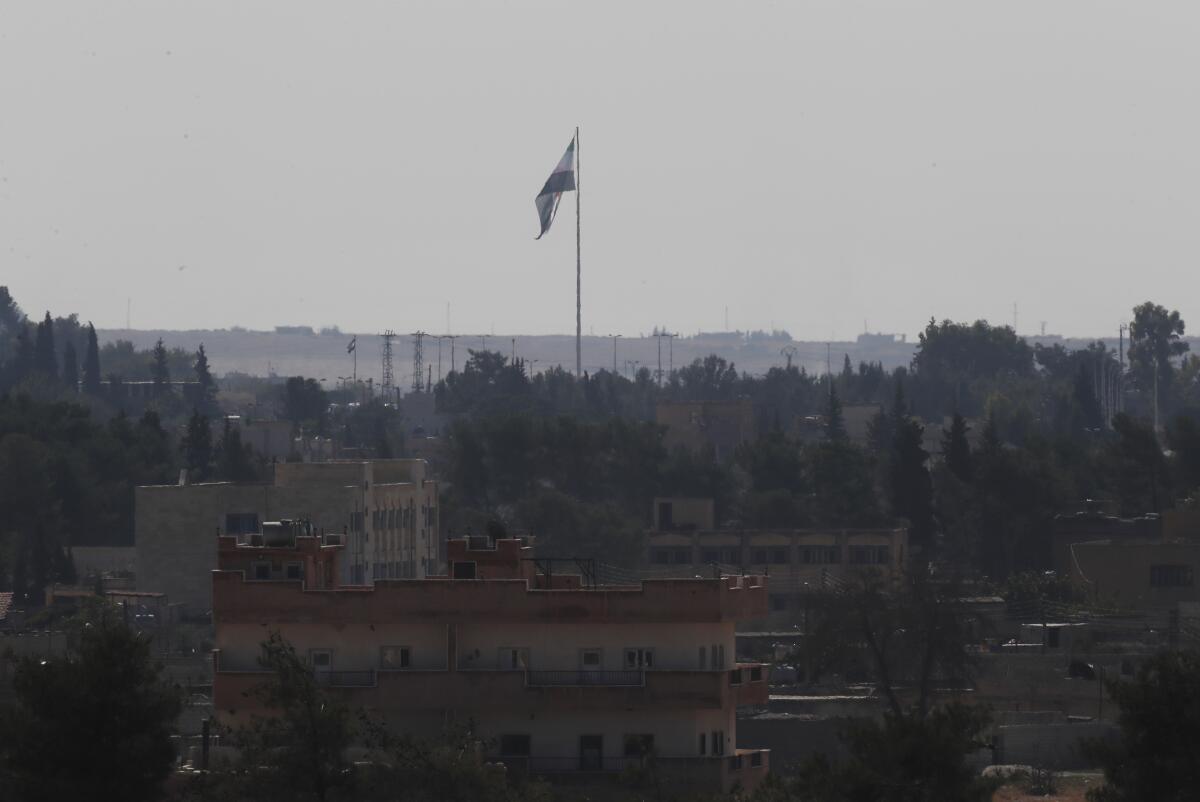News Analysis: Russian and Syrian troops take the place of Kurdish forces in key cities

- Share via
IRBIL, Iraq — In 2014, Kurdish-led forces, aided by U.S. air power, pushed back Islamic State militants who invaded the Syrian city of Kobani.
The city of Raqqah — the headquarters of the extremists’ self-declared caliphate in Syria — fell to the same Kurdish-led militiamen in 2017.
Those triumphs, which cost thousands of Kurdish lives, were celebrated as gallant victories of the U.S.-Kurdish alliance. Now they seem part of a distant past.
Photographs circulating on social media Wednesday showed Russian troops patrolling the streets of Kobani and convoys of Syrian troops entering Raqqah — one day after Russia and Turkey unveiled a deal to divvy up control of northeastern Syria.
The Kurdish forces will see a reduced prominence. Their U.S. allies are on the way out, decamping in armored vehicles flying the Stars and Stripes as angry Kurdish civilians pelt them with potatoes.
Stepping in to fill the power vacuum are Russia, Turkey and the Syrian government.
The deal — announced by Russian President Vladimir Putin and Turkish counterpart Recep Tayyip Erdogan in the Black Sea resort of Sochi — has fundamentally reshaped the battle lines.
The agreement gave no party everything it wanted, and the Kurds and the United States were not directly involved in the talks.
But the Turks, the Syrian government, the Kurds and especially the Russians all came away with something. And, at least for the moment, further bloodshed was averted.
The retreating Americans appeared to be the big losers, conceding their power-broker role to the Russians, who have emerged as the key intermediaries between the antagonistic governments in Damascus and Ankara.
But President Trump seemed unperturbed about talk of a diminution in U.S. leverage.
“Let someone else fight over this long-bloodstained sand,” he told reporters Wednesday, defending the U.S. pullout.
Having lost U.S. backing, the Syrian Democratic Forces — the largely Kurdish militia that controlled much of northeastern Syria in recent years — at most could become a junior partner of the Syrian government’s military.
Under terms of the accord, Kurdish forces are obliged to remain nearly 19 miles south of the Turkish border. That is a concession to Ankara’s concerns about the Syrian militia’s deep links to Kurdish insurgents in southeastern Turkey. The Syrian Kurds were given six days to complete the pullback, which was to be overseen by Russian military police and Syrian government forces.
A mix of Syrian government, Russian, and, in some limited cases, Turkish troops, will be responsible for security along border areas in the northeast.
The deal also calls for all Kurdish fighters to leave the Syrian cities of Manbij and Tal Rifaat, which they helped liberate from Islamic State militants. In both cases, the Kurds had already asked the Syrian military to move into the cities.
The 10-point agreement does not call for the disbanding of the Kurdish force or label the Kurdish fighters “terrorists,” as Erdogan routinely refers to them.
The Kurdish-led forces, which claim to have 70,000 fighters, will be left to work out a coexistence with the Syrian government army. That may not be as difficult as it seems: There have long been informal understandings between the two secular military forces, both of which have battled Islamist militias in recent years.
The Kurds could theoretically prove a key asset as Damascus moves to flush out the remaining pockets of anti-government forces, especially in northwest Syria’s Idlib province.
Syrian President Bashar Assad has made it clear that he wants to recapture “every inch” of the nation, an objective that not long ago seemed illusory.
The Sochi agreement, however, would seem to go a long way toward helping Assad achieve that goal. The Kurdish-controlled area that is now set to return to the government fold amounts to a third of Syria’s national territory and includes much of the country’s oil wealth and some of its best agricultural land.
With Syrian government forces stretched thin, the Kurds could be in a strong position to push for some measure of autonomy.
For Turkey, the big prize in the Sochi deal was recognition of its “safe zone” along an 80-mile-wide, 20-mile-deep stretch of international boundary between the Syrian border towns of Tal Abyad and Ras al-Ayn. The strip probably will be placed under the leadership of Turkish-sponsored Arab militiamen, including some Sunni Muslim militants.
The loss of Ras al-Ayn, a historically Kurdish town, is a blow for the Kurds. Thousands of Kurds fled once Turkey began its offensive on Oct. 9.
A number of other Kurdish-majority border towns — including Kobani and Qamishli — remained out of the Turkish orbit, to be patrolled by Syrian army and Russian forces.
The “safe zone” is where Erdogan wants to relocate about 2 million Syrian refugees in Turkey, where their presence has caused him some political fallout.
Russia appears to have succeeded in tamping down Erdogan’s demands for a wider Turkish-controlled border strip.
On Wednesday, the Turkish military command said it had halted its advance into Syria after the signing of the Sochi accord.
“Turkey will never allow a terrorist corridor to be formed south of its borders,” the Turkish Defense Ministry said.
The families of Erdogan and Assad once vacationed together. But Syria’s bloody, eight-year war caused a profound falling-out between the two leaders.
Assad recently denounced Erdogan, who sponsored years of rebel attacks against Damascus, as a “thief,” land-grabber, and “slave” to Washington. Erdogan has called Assad a mass murderer and “terrorist.”
Syria and Turkey share more than 500 miles of mostly unguarded international boundary, much of it long traversed by smugglers and armed factions. There is plenty of room for cross-border disruption if either side is unhappy with the deal struck in Sochi.
More to Read
Sign up for Essential California
The most important California stories and recommendations in your inbox every morning.
You may occasionally receive promotional content from the Los Angeles Times.













